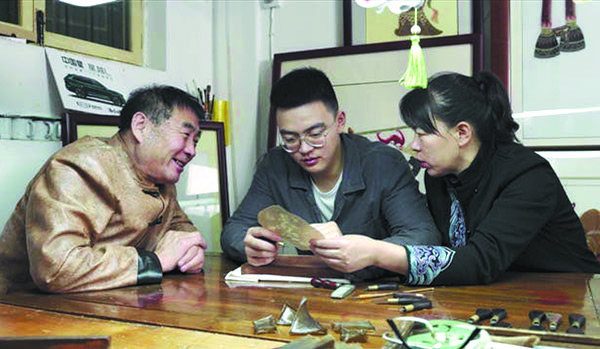The heritage hidden in shadows
By Li Yingxue | China Daily | Updated: 2023-12-07 08:09

Nanxiang Buaichifan says that Dang and the other teachers he worked with generously imparted their knowledge in the hope that the younger generation finds ways to convey the essence of shadow puppetry in a manner that resonates with today's youth.
"In an age without smartphones, traditional performances were what kept our country entertained for thousands of years. Without elaborate props or teams of actors, a single performer is able to evoke the grandeur of armies, traversing the millennia," he says.
Jiuyue says: "The small shadow puppet transcends artistry; it embodies a fragment of history, a slice of culture, and a chapter in the annals of folk art."
As Dang explains, Chinese shadow puppetry has its roots in the Han Dynasty (206 BC-AD 220), and the Shaanxi tradition has been associated with royal artistry since its inception, and is known for its exquisite craftsmanship.
"It gradually transitioned from royal to folk art, spreading outward with Shaanxi at its core. You can even trace its presence along the Silk Road," says Dang, who was born and raised in Xi'an.
From watching his grandfather and mother make shadow puppets since childhood, Dang gradually acquired the skill himself. "It's like standing beside a chef, smelling the aromas and intuitively knowing what ingredients to add to the pot," Dang says.

The core technique of Wang's Shadow lies in the art of pushing the leather while the tip of the knife remains stationary. With the application of force from just a few fingers, tough bull hide is maneuvered against the knife's edge, resulting in lines that are not only sharp and clean, but also intricate and delicate.
When it comes to the crucial wrist and forearm strength needed, Dang chose a different path to his elders. Rather than employ the traditional method of hanging weights on the wrist, he opted for a modern approach — hitting the gym and lifting dumbbells. "The younger generation today connects with fundamentals in different ways," he says.
In 2019, Dang enrolled at Northwest University in Xi'an to major in biology. "I enjoy studying biology, including researching interesting mountain animals like golden monkeys," he says.
Due to the pandemic, he took most of his classes online, which gave him more time to take over the family business, and he has postponed graduation for a year to give more attention to promoting shadow puppet culture.
During the China-Central Asia Summit in Xi'an in May, Dang and his team designed a 10-meter hallway with shadow puppets for the attendees.
"We used the puppets to illustrate female heroes from films, along with many colorful scenes and maps depicting countries involved in the Belt and Road Initiative," Dang says.
Traditional Wang's Shadow puppets are mostly destined for collection. However, Dang thinks that this should not be the only choice.
His team has around 10 craftsmen, mostly middle-aged, who have studied with his mother and grandfather for many years. This year, with his family's support, Dang is expanding the team and wants to be involved in more cultural and innovative projects.
"We need to seamlessly integrate shadow play into our lives, to make it attractive to the younger generation, so that this cultural tradition thrives, rather than remain confined to lifeless museum exhibits," he adds.
He envisions incorporating shadow puppet elements into various aspects of daily life, including clothing, food, housing and transportation, through more interdisciplinary collaborations.
"We aim to demonstrate the excellence of our traditional culture, and its ability to produce remarkable creations. Once people realize that shadow puppets can be cool, their natural inclination will be to become involved," he says.
























